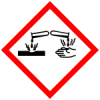Coalition status
Fairtrade Orange
This list contains 39 pesticides. The list is valid as of January 2018. Pesticides that may only be used under very specific conditions, for example…
FSC restricted HHPsChemical pesticide presenting one out of three of the following hazards: acute toxicity, chronic toxicity and environmental toxicity.
GCP-Phase-Out 2030Use of pesticides in the Phase-out List are reduced through use of Integrated Pest Management and phased out by 2030, if feasible. This includes…
UTZ WatchlistUTZ Watchlist is composed of active ingredients that are not banned but that have a potentially severe and/or cumulative risk for human health and/or…
Details
Type: Pesticide
Use: Herbicide
Example applications: Agriculture including cereals;Soybeans;Glyphosate tolerant crops;Horticulture;Forestry;Domestic gardens & lawns.
Example pests controlled: Annual and perennial weeds, Broad-leaved weeds, Grasses
Mode of action: Broad-spectrum, systemic, contact action, translocated and non-residual acivity. Inhibits EPSP synthase.
Source: PPDB
Toxicty
IARC Group 2A
This designation is applied when there is limited evidence of carcinogenicity in humans as well as sufficient evidence of carcinogenicity in…
GHS safety labels
About Globally Harmonized System of Classification and Labelling of Chemicals (GHS)
From Wikipedia: The Globally Harmonized System of Classification and Labelling of Chemicals (GHS) is an internationally agreed-upon standard managed by the United Nations that was set up to replace the assortment of hazardous material classification and labelling schemes previously used around the world. Core elements of the GHS include standardized hazard testing criteria, universal warning pictograms, and harmonized safety data sheets which provide users of dangerous goods with a host of information. The system acts as a complement to the UN Numbered system of regulated hazardous material transport. Implementation is managed through the UN Secretariat. Although adoption has taken time, as of 2017, the system has been enacted to significant extents in most major countries of the world.[1] This includes the European Union, which has implemented the United Nations' GHS into EU law as the CLP Regulation, and United States Occupational Safety and Health Administration standards.
- H318

Causes serious eye damage
Class: (Corrosion)Damage/irritation
Subclass: Eye - H411

Toxic to aquatic life with long lasting effects
Class: Aquatic
Subclass: Chronic
